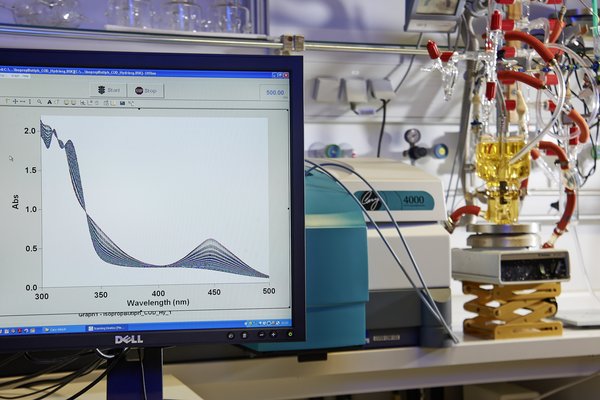Optical Spectroscopies
These methods use electromagnetic waves that propagate according to the laws of classical optics. Of particular interest are the infrared region (heat radiation), the visible and the near-ultraviolet wavelength range.
Infrared Spectroscopy (IR)
Radiation in the infrared region gives rise to molecular vibrations. These may be used to gain information on the structure of matter. We use infrared spectroscopy therefore predominantly for the characterisation of chemical substance (qualitative or structural analysis).
Equipment: Bruker Alpha FT-IR-Spektrometer
- Spectral range (wavenumbers) 7500-375 cm–1 (corresponds to wavelengths 1.3-27 mm)
- The standard procedure for solid and liquid samples is measurement by the ATR technique (attenuated total reflection)
- Upon special request, liquids or solutions may also be measured in transmission mode (cuvettes with windows made from CaF2- are available)
The research groups “Optical Spectroscopic and Thermoanalytical Methods“, “New Hydroformylation Catalysts“ and “Vibrational Spectroscopy“ work with further IR instruments with advanced equipment to solve catalysis-specific issues.
UV/Vis Spectroscopy
Absorption of light from the ultraviolet and visible spectral region can push electrons in the atomic shell to a higher energy level. This phenomenon is responsbile for the colour of matter and very useful both for qualitative characterisation and quantitative determination.
Equipment: Perkin-Elmer Lambda 2 UV-Spectrophotometer
- Spectral range (wavelengths) 190-1100 nm
- We can measure liquid samples (solutions) in transmission mode, cuvettes made from quartz with path lengths up to 10 cm are available
The Lambda 2 instrument is used for collecting routine spectra and for quantitative determination of some elements (P, Rh, Ti, e.g.) by photometric analysis.
The research groups “Optical Spectroscopy and Thermoanalytical Methods“ and “Mechanisms in Homogeneous Catalysis“ work with further UV/Vis-instruments with advanced equipment to solve catalysis-specific issues.
CD/ORD Spectroscopy (Circular Dichroism/Optical Rotatory Dispersion)
… is a special case of UV/Vis spectroscopy that uses polarised light and used to tackle stereochemical problems. Many otherwise identical molecules may differ in the spatial arrangement of their atoms in the molecules, they behave like an object and its image in a mirror (for example, a glove for the right hand and its counterpart for the left hand). This is called “chirality” and the molecules are “optically active”. All biological macromolecules (proteins, starch, nucleic acids, …) are chiral. Optically active molecules interact with optically active biological material in a different way (depending on their chirality) which may be crucial with pharmaceuticals or agrochemicals. CD/ORD belongs the small number of methods that allow to discriminate chiral molecules and to determine their “absolute configuration”—whether the glove fits the right or the left hand.
Equipment: Jasco J-710 Spectropolarimeter
- Spectral Range (wavelengths) 175-800 nm
- Additional devices for experiments under peculiar conditions (reacting systems, specific temperatures and under controlled atmosphere, i.e., gaseous reaction partners in situ)
This instrument can only be used upon special request and not as a regular service.

